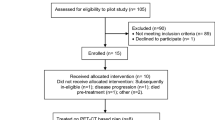Abstract
Purpose
FDG PET is increasingly used in radiotherapy planning. Recently, we demonstrated substantial differences in target volumes when applying different methods of FDG-based contouring in primary lung tumours (Nestle et al., J Nucl Med 2005;46:1342–8). This paper focusses on FDG-positive mediastinal lymph nodes (LNPET).
Methods
In our institution, 51 NSCLC patients who were candidates for radiotherapy prospectively underwent staging FDG PET followed by a thoracic PET scan in the treatment position and a planning CT. Eleven of them had 32 distinguishable non-confluent mediastinal or hilar nodal FDG accumulations (LNPET). For these, sets of gross tumour volumes (GTVs) were generated at both acquisition times by four different PET-based contouring methods (visual: GTVvis; 40% SUVmax: GTV40; SUV=2.5: GTV2.5; target/background (T/B) algorithm: GTVbg).
Results
All differences concerning GTV sizes were within the range of the resolution of the PET system. The detectability and technical delineability of the GTVs were significantly better in the late scans (e.g. p = 0.02 for diagnostic application of SUVmax = 2.5; p = 0.0001 for technical delineability by GTV2.5; p = 0.003 by GTV40), favouring the GTVbg method owing to satisfactory overall applicability and independence of GTVs from acquisition time. Compared with CT, the majority of PET-based GTVs were larger, probably owing to resolution effects, with a possible influence of lesion movements.
Conclusion
For nodal GTVs, different methods of contouring did not lead to clinically relevant differences in volumes. However, there were significant differences in technical delineability, especially after early acquisition. Overall, our data favour a late acquisition of FDG PET scans for radiotherapy planning, and the use of a T/B algorithm for GTV contouring.




Similar content being viewed by others
References
Armstrong JG. Target volume definition for three-dimensional conformal radiation therapy of lung cancer. Br J Radiol 1998;71:587–94.
Nestle U, Hellwig D, Schmidt S, Licht N, Walter K, Ukena D, et al. 2-Deoxy-2-[18F]fluoro-D-glucose positron emission tomography in target volume definition for radiotherapy of patients with non-small cell lung cancer. Mol Imaging Biol 2002;4:257–63.
Nestle U, Walter K, Schmidt S, Licht N, Nieder C, Motaref B, et al. 18F-deoxyglucose positron emission tomography (18FDG-PET) for the planning of radiotherapy in lung cancer: high impact in patients with atelectasis. Int J Radiat Oncol Biol Phys 1999;44:593–7.
Hebert ME, Lowe VJ, Hoffman JM, Patz EF, Anscher MS. Positron emission tomography in the pretreatment evaluation and follow-up of non-small cell lung cancer patients treated with radiotherapy: preliminary findings. Am J Clin Oncol 1996;19:416–21.
Munley MT, Marks LB, Scarfone MS, Hoffman JM, Patz EF, Anscher MS, et al. Multimodality nuclear medicine imaging in three-dimensional radiation treatment planning for lung cancer: challenges and prospects. Lung Cancer 1999;23(2):105–14.
Ciernik IF, Dizendorf E, Baumert BG, Reiner B, Burger C, Davis JB, et al. Radiation treatment planning with an integrated positron emission and computer tomography (PET/CT): a feasibility study. Int J Radiat Oncol Biol Phys 2003;57:853–63.
Giraud P, Grahek D, Montravers F, Carette MF, Deniaud-Alexandre E, Julia F, et al. CT and 18F-deoxyglucose (FDG) image fusion for optimization of conformal radiotherapy of lung cancers. Int J Radiat Oncol Biol Phys 2001;49:1249–57.
MacManus M, Hicks RJ, Matthews JP, Hogg A, McKenzie AF, Wirth A, et al. High rate of detection of unsuspected distant metastases by PET in apparent stage III non-small-cell lung cancer: implications for radical radiation therapy. Int J Radiat Oncol Biol Phys 2001;50(2):287–93.
Mah K, Caldwell CB, Ung YC, Danjoux CE, Balogh JM, Ganguli SN, et al. The impact of 18FDG-PET on target and critical organs in CT-based treatment planning of patients with poorly defined non-small cell lung carcinoma: a prospective study. Int J Radiat Oncol Biol Phys 2002;52:339–50.
Bradley J, Thorstad WL, Mutic S, Miller TR, Dehdashti F, Siegel BA, et al. Impact of 18FDG-PET on radiation therapy volume delineation in non-small cell lung cancer. Int J Radiat Oncol Biol Phys 2004;59:78–86.
Vanuytsel LJ, Vansteenkiste JF, Stroobants SG, De Leyn PR, De Wever W, Verbeken EK, et al. The impact of 18F-fluoro-2-deoxy-D-glucose positron emission tomography (FDG-PET) lymph node staging on the radiation treatment volumes in patients with non-small cell lung cancer. Radiother Oncol 2000;55:317–24.
Ashamalla H, Rafla S, Parikh K, Mokhtar B, Goswami G, Kambam S, et al. The contribution of integrated PET/CT to the evolving definition of treatment volumes in radiation treatment planning in lung cancer. Int J Radiat Oncol Biol Phys 2005;63(4):1016–23.
Nestle U, Kremp S, Schaefer-Schuler A, Sebastian-Welsch C, Hellwig D, Rübe C, et al. Comparison of different methods for delineation of 18F-FDG PET-positive tissue for target volume definition in radiotherapy of patients with non-small cell lung cancer. J Nucl Med 2005;46(8):1342–8.
Matthies A, Hickeson M, Cuchiara A, Alavi A. Dual time point 18-F-FDG-PET for the evaluation of pulmonary nodules. J Nucl Med 2002;43:871–5.
Hamberg LM, Hunter GJ, Alpert NM, Choi NC, Babich JW, Fischman AJ. The dose uptake ratio as an index of glucose metabolism: useful parameter or oversimplification? J Nucl Med 1993;35:1308–12.
Yamada S, Kubota K, Kubota R, Ido T, Tamahashi N. High accumulation of fluorine-18-fluorodeoyxglucose in turpentine-induced inflammatory tissue. J Nucl Med 1995;36:1301–6.
Zhuang H, Pourdehnad M, Lambright E, Yamamoto AJ, Lanuti M, Li P, et al. Dual time point 18F-FDG PET imaging for differentiating malignant from inflammatory processes. J Nucl Med 2001;42:1412–7.
Kremp S, Schaefer-Schuler A, Nestle U, Sebastian-Welsch C, Rübe C, Kirsch C-M. Comparison of CT and CT-PET-fusion based 3D treatment plans in the percutaneous radiotherapy of lung cancer [abstract]. Radiother Oncol 2004;73 Suppl 1:S447–8.
Dwamena BA, Sonnad SS, Angobaldo JO, Wahl RL. Metastases from non-small cell lung cancer: mediastinal staging in the 1990s-meta-analytic comparison of PET and CT. Radiology 1999;213:530–6.
Gambhir SS, Czernin J, Schwimmer J, Silverman DH, Coleman RE, Phelps ME. A tabulated summary of the FDG PET literature. J Nucl Med 2001;42:1S–93S.
Kiffer JD, Berlangieri SU, Scott AM, Quong G, Feigen M, Schumer W, et al. The contribution of 18F-fluoro-2-deoxy-glucose positron emission tomographic imaging to radiotherapy planning in lung cancer. Lung Cancer 1998;19:167–77.
Paulino AC, Johnstone PA. FDG-PET in radiotherapy treatment planning: Pandora’s box? Int J Radiat Oncol Biol Phys 2004;59:4–5.
Erdi YE, Mawlawi O, Larson SM, Imbriaco M, Yeung H, Finn R, et al. Segmentation of lung lesion volume by adaptive positron emission tomography image thresholding. Cancer 1997;80 Suppl:2505–9.
Scarfone C, Lavely WC, Cmelak AJ, Delbeke D, Martin WH, Billheimer D, et al. Prospective feasibility trial of radiotherapy target definition for head and neck cancer using 3-dimensional PET and CT imaging. J Nucl Med 2004;45:543–52.
Black QC, Grills IS, Kestin LL, Wong CY, Wong JW, Martinez AA, et al. Defining a radiotherapy target with positron emission tomography. Int J Radiat Oncol Biol Phys 2004;60:1272–82.
Daisne JF, Sibomana M, Bol A, Doumont T, Lonneux M, Gregoire V, et al. Tri-dimensional automatic segmentation of PET volumes based on measured source-to-background ratios: influence of reconstruction algorithms. Radiother Oncol 2003;69:247–50.
Geets X, Daisne JF, Gregoire V, Hamoir M, Lonneux M. Role of 11-C-methionine positron emission tomography for the delineation of the tumor volume in pharyngo-laryngeal squamous cell carcinoma: comparison with FDG-PET and CT. Radiother Oncol 2004;71:267–73.
Stevens CW, Munden RF, Forster KM, Kelly JF, Liao Z, Starkschall G, et al. Respiratory-driven lung tumor motion is independent of tumor size, tumor location, and pulmonary function. Int J Radiat Oncol Biol Phys 2001;51:62–8.
Caldwell CB, Mah K, Skinner M, Danjoux CE. Can PET provide the 3D extent of tumor motion for individualized internal target volumes? A phantom study of the limitations of CT and the promise of PET. Int J Radiat Oncol Biol Phys 2001;55:1381–93.
De Ruysscher D, Wanders S, van Haren E, Hochstenbag M, Geeraedts W, Utama I, et al. Selective mediastinal node irradiation based on FDG-PET scan data in patients with non-small-cell lung cancer: a prospective clinical study. Int J Radiat Oncol Biol Phys 2005;62:988–94.
Acknowledgements
The authors wish to thank the staff of the two departments, and especially Ms. Susanne Bock, for their help in data acquisition. Furthermore, we thank Dr. Aleks Grgic for his assistance in radiodiagnostic questions, and Mr. Andrew Page for his help in the wording of the manuscript.
Author information
Authors and Affiliations
Corresponding author
Rights and permissions
About this article
Cite this article
Nestle, U., Schaefer-Schuler, A., Kremp, S. et al. Target volume definition for 18F-FDG PET-positive lymph nodes in radiotherapy of patients with non-small cell lung cancer. Eur J Nucl Med Mol Imaging 34, 453–462 (2007). https://doi.org/10.1007/s00259-006-0252-x
Received:
Accepted:
Published:
Issue Date:
DOI: https://doi.org/10.1007/s00259-006-0252-x




